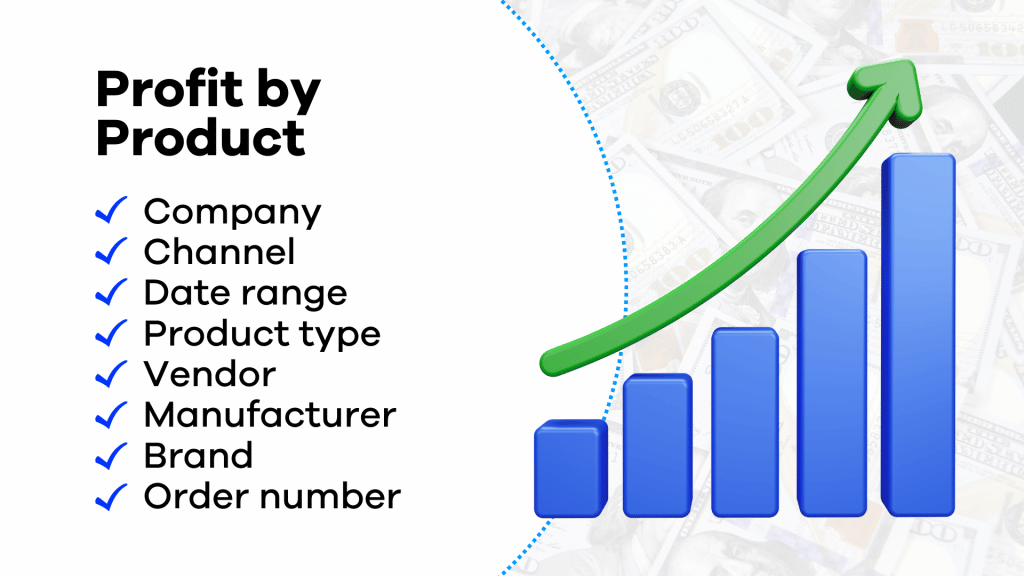As you scale your ecommerce business, it can be easy to mistake rising profits for maximized profitability. Not so fast. Just because your bottom line is increasing doesn’t mean that it is rising as quickly as it could be.
There are several critical reports you should be monitoring to know just how profitable your ecommerce business is. The devil is in the details when it comes to ecommerce. Trends, fluctuations, and outliers lurking across your entire operation could cost you money. You’ll never know if you aren’t looking.
Descartes Sellercloud is an all-in-one ecommerce growth platform dedicated to making it easy to generate meaningful reports like these and implement data-driven strategies and workflows in response.
1. Profit & Loss (P&L) Per Order
In the most basic terms, an order is only profitable if it costs you less than the revenue it generates. In ecommerce, the cost side of the balance sheet includes several variables:
- Item costs.
- Listing fees.
- Marketplace commissions.
- Transaction processing fees.
- Shipping and handling costs.
- Warehousing costs.
- Sales tax.
These variables will inevitably fluctuate depending on the products you sell, where you sell them, industry trends, vendors, and logistics partners. Regularly tracking these costs and fees is the only way to have a handle on the true profitability of your products and ecommerce business as a whole.
Sudden fluctuations could signal the need to reevaluate areas of your operation, like shipping providers, merchandise suppliers, and sales channels. Likewise, notable changes in your sales margins (either positive or negative) may indicate a need to reevaluate your pricing or assess the potential effects of market competitors.
Descartes Sellerlcoud’s robust P&L reporting features make evaluating your profit margins simple. Our platform puts P&L analysis at your fingertips. You can generate reports customized by date range, customer, order, vendor, channel, brand, and more. As a result, you remove the mystery of your ecommerce business’s profitability and unlock ways to further optimize your bottom line.
2. Profit by Product
When you sell multiple products, each SKU impacts your overall profitability. Moreover, each SKU has a unique lifecycle, which dictates its rise and fall as a revenue driver. Tracking P&L on a per-product basis is the only way to truly understand the performance of what you are selling.
Descartes Sellercloud’s Profit by Product Summary report makes it possible to do just that. You can isolate the full transaction details for any SKU or group of SKUs in your catalog using filters such as:
- Company.
- Channel.
- Date range.
- Product type.
- Vendor.
- Manufacturer.
- Brand.
- Order number.
The resulting reports can make it easier to spot trends affecting profitability, like purchasing cost fluctuations, seasonality, and SKU maturity.

3. Profit by Channel
Omnichannel ecommerce has become an industry gold standard. A multichannel approach to online sales is crucial to maximizing product exposure and brand growth. Just as you need to understand how effectively each of your products is selling, you need to pay attention to how these profitability figures correlate to the channels where you sell them.
In many cases, listing your entire catalog across every channel is not always the key to optimizing conversions. Descartes Sellercloud’s Profit by Order Summary allows sellers to summarize transactions using a number of different variables, including channel.
Not only does this allow you to surface the P&L metrics associated with the marketplaces and websites where you sell, but you can also drill down to target specific products and product groups’ performances on a per-channel basis. Not all sales channels are created equal. Some products may become more popular on particular channels than others.
Similarly, some channels may cost you more fees and fulfillment costs than others. These P&L disparities can be critical in deciding which products to market where.
4. Actual Shipping Costs
Most ecommerce brands rely on third-party partners to receive merchandise, move inventory between warehouses, and ship orders. The associated shipping costs are always subject to change. As such, you need to actively monitor your end-to-end shipping costs to ensure that you use the most reliable and cost-effective shipping options.
Even slight savings or price increases can have substantial implications for your bottom line when multiplied across a high volume of shipments. As an all-in-one ecommerce platform, Descartes Sellercloud makes it possible to track the P&L impact of all of your shipping costs.
Businesses can also import actual carrier shipping costs from invoices rather than relying on the estimated costs applied when an order is placed. This commitment to accuracy means that you have the best possible data to utilize in your carrier-related decision-making.
Should you need to explore new shipping partnerships, Descartes Sellercloud’s integrations with the world’s most popular and reliable shipping providers make it possible to onboard new fulfillment workflows quickly and smoothly.
5. Inventory Value
One of the easiest elements of profitability to overlook is the carrying costs associated with the merchandise you have yet to sell. First, you need to be sure that you have an accurate inventory and stock count. A regular inventory cycle-counting protocol can ensure that you start by accurately assessing what you have and where.
From there, Descartes Sellercloud’s Inventory by Warehouse Summary allows you to track the value of your inventory across each location where your merchandise is stored. The valuation method can be adjusted between first-in-first-out (FIFO) and last-in-first-out (LIFO) according to the best-suited method for your business and products.
Additionally, the Unsold Inventory report allows you to tally the costs associated with your stored inventory. These reports allow you to monitor your inventory turnover ratio and set your ideal buffer inventory and stock levels. You can be sure you have enough inventory to fulfill orders while minimizing the costs of paying for unnecessary storage.
Getting serious about profitability means getting serious about your ecommerce data. These are just a few reporting features available to Descartes Sellercloud users that can surface the profitability realities.
Contact us for a free demo of how our entire family of tools and products can help you unlock your business’s highest potential.




